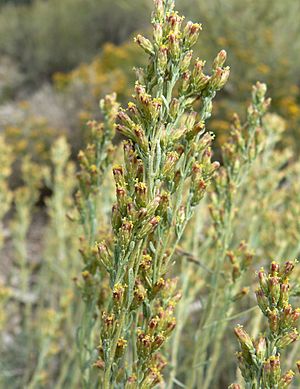Black sagebrush facts for kids
Quick facts for kids Black sagebrush |
|
|---|---|
 |
|
| Scientific classification | |
| Genus: |
Artemisia
|
| Species: |
nova
|
| Synonyms | |
|
Seriphidium novum (A.Nelson) W.A.Weber |
|
Artemisia nova, also known as black sagebrush, is a common type of sagebrush plant found in North America. It's one of the most widespread shrubs in the western United States.
Where Does Black Sagebrush Grow?
Black sagebrush grows naturally across a large part of the western United States. You can find it from the Mojave Desert mountains in southern California all the way to New Mexico. It also grows north into states like Oregon, Idaho, and Montana.
This plant thrives in many different places. It can be found in forests, woodlands, and open grasslands.
Understanding Black Sagebrush
Sometimes, it can be tricky to tell black sagebrush apart from other similar plants. It looks a lot like Artemisia arbuscula, which is called Little sagebrush.
Black sagebrush can also mix with Big sagebrush (Artemisia tridentata) if they grow in the same area. When this happens, they create new plants that have features from both types.
There are also two main forms of Artemisia nova. One form is darker and easy to spot. The other is a lighter gray-green color, which can look very similar to other kinds of sagebrush.
What Does Black Sagebrush Look Like?
Black sagebrush is usually a small, upright shrub. It has stems that branch out from a central, trunk-like base. Most of the time, it grows to be about 20 to 30 centimeters tall. However, some plants can grow much taller, even over 70 centimeters!
Its leaves are green, short, and narrow. They often have a few small teeth at their tips. These leaves also have a nice, strong smell. One way to tell this plant apart is by the tiny, sticky hairs on its leaves.
The plant produces clusters of flower heads. These flower heads are covered with shiny, oily, yellow-green leaves called phyllaries. The tips of these phyllaries are clear, almost like glass. After the flowers, the plant produces tiny fruits called achenes, which are less than a millimeter long.
Black sagebrush mostly grows new plants from its seeds. It's very rare for it to reproduce in other ways, like by layering.

